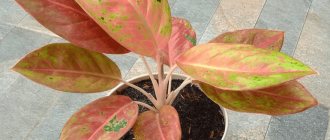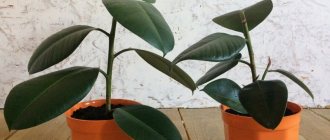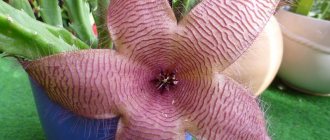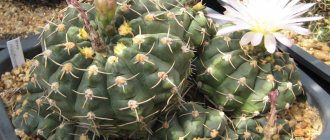Author: Elena N. https://floristics.info/ru/index.php?option=com_contact&view=contact&id=19 Category: Houseplants Published: August 14, 2018Last edits: January 11, 2021
- Diseases and their treatment
- Pachypodium lamerei
Pachypodium (lat. Pachypodium) is a genus of tree-like plants of the Kutrovye family, which grow in the arid regions of Madagascar, Africa and Australia. There are 23 species in the genus. Translated from Greek, “pachypodium” means “thick leg”: the plant has a voluminous, fleshy and prickly trunk. In nature, pachypodium can reach a height of eight meters and a diameter of one and a half meters, but at home this tree does not grow above a meter.
Planting and caring for pachypodium
- Flowering: in spring, first time - in the sixth or seventh year of life.
- Lighting: bright diffused light.
- Temperature: in summer – from 20 to 30 ºC, in winter – 16-18 ºC. Protect the plant from drafts!
- Watering: in spring and summer - moderate, when the substrate dries to a depth of 1 cm, in winter - rare and meager. After dropping the leaves, stop watering. The short-stemmed species requires scanty watering throughout the year.
- Humidity: normal.
- Feeding: from early spring to mid-autumn once a month with fertilizers for cacti.
- Dormant period: approximately November to March.
- Transplantation: young plants - every spring, adults - once every 3-4 years.
- Reproduction: by seeds, less often by cuttings.
- Diseases: fungal rot.
- Pests: spider mites, thrips.
- Properties: the plant has poisonous juice!
Read more about growing pachypodium below.
Botanical description
Pachypodiums are succulent shrubs or trees, the characteristic feature of which, despite the many differences between species and varieties, is a thick trunk that retains a supply of water in case of drought. Otherwise, the appearance of Pachypodium species is varied and ranges from bottle-shaped dwarfs to cactus-like trees. Almost all types of pachypodium are equipped with spines, which are grouped in triplets or pairs and arranged spirally or in rings around the trunk. Branching is also characteristic of plants of this genus, but among pachypodiums there are species that do not form branches. Unlike other representatives of the Kutrovye family, the juice of pachypodiums is not milky, but transparent, although just as poisonous.
In indoor culture, the pachypodium plant grows from 30 to 150 cm, and its lifespan is from 3 to 15 years.
Pachypodium care at home
Growing conditions
Pachypodium needs a lot of light, and it is not afraid of sunlight. In the summer, he will feel great on the balcony or in the garden, but he needs to be accustomed to the open air. It is better to keep the flower indoors on a south, south-west or south-east window sill. When spring comes after short winter days, the pachypodium also needs to be gradually accustomed to exposure to direct sunlight.
- How to grow cacti in a garden where winter temperatures drop below -20°C
Pachypodium loves fresh air, but does not tolerate drafts. Temperature in the summer does not play a special role for the plant: pachypodium grows and develops well at both 20 and 30˚C. In winter, the plant requires cool maintenance: the pachypodium spends its dormant period at 16-18 ˚C.
Watering
Caring for home pachypodium is simple. In spring and summer, watering should be moderate so that the soil in the pot is slightly moist all the time. If the plant lacks water, it will shed its leaves and lose its attractiveness, and if there is a lot of moisture, the pachypodium at home will begin to stretch painfully, which will also not add decorative value to it. Water the plant when the soil in the pot dries to a depth of 1 cm. Short-stemmed pachypodium requires scanty watering throughout the year. If the plant has dropped its leaves, stop watering altogether, and after 5-6 weeks the leaves will grow back.
About growing milkweed - a lot of species and varieties
The plant does not need high air humidity, but it will favorably accept your care if you wipe its leaves with a damp sponge from time to time and spray it with settled water at room temperature from a spray bottle. By the way, water for irrigation also needs to be settled.
Fertilizer
The pachypodium plant is fertilized from early spring, when new shoots begin to grow, until mid-autumn. Fertilizer in the form of a fertilizer solution for cacti is applied to pre-moistened soil once a month.
You cannot fertilize pachypodium for a month after transplantation and when it is sick.
Before entering the dormant period, feeding is stopped and resumed only next spring.
- Sedum: growing from seeds, types and varieties
Transfer
Young pachypodiums need to be transplanted into a larger pot every spring, and adults once every three or even four years. Moderately acidic soil for cacti is optimal for the plant. If you can’t find it in the store, you can make a substrate from equal parts of coarse-grained river sand, turf and leaf soil. To improve drainage qualities, brick chips or charcoal should be added to the substrate. However, this does not eliminate the need to place a layer of expanded clay in the pot when replanting, filling the container to a third of its volume.
When replanting indoor pachypodium, try to act carefully so as not to damage the root system of the plant. If the succulent is healthy, simply transfer it from the old pot to the new one and fill the remaining space with potting soil. Free a plant with diseased roots from the old soil, remove rotten or dried areas, treat the wounds with charcoal powder and only then complete the replanting.
Pachypodium flowering
The indoor pachypodium flower grows very slowly, so you have to wait six or seven years for its first flowering, but if the plant is poorly or improperly cared for, it may not bloom at all. Follow the rules for caring for your succulent, avoid drafts in the room, make sure the plant gets enough food and light, and then one day you will be lucky enough to see pachypodium flowers.
Virulence
Pachypodium secretes poisonous juice, which irritates mucous membranes and corrodes wounds on the skin, so it should be washed off immediately with plenty of water.
In the photo: How pachypodium blooms in an apartment
Conditions of detention
Despite the unpretentiousness of pachypodium varietal species, the plant is sensitive to external conditions. The tree grows slowly; if basic maintenance requirements are not met, it can go into hibernation and stop development. It is recommended to provide high-quality lighting, moderate humidity and choose the right place for growing.
Lighting
Pachypodium is a light-loving palm; with regular darkening, its decorative effect is reduced and growth slows down. The plant prefers continuous and diffused light; exposure to direct sunlight can lead to drying of the leaves and trunk. In summer it is possible to keep it on a glassed-in balcony or loggia, but it is advisable to bring the pot home at night. It is recommended to place the tree on the eastern or western windowsill of the apartment.
Temperature and humidity
The plant has pronounced periods of dormancy and vegetation. Active growth is observed from spring to early autumn, during which time it is recommended to maintain the temperature in the range of 18-28 oC. In winter, when the palm tree is dormant, the heat should be reduced to 14-17 oC.
Like other succulents, pachypodium can tolerate prolonged drought. The flower is unpretentious to indoor humidity and feels comfortable in an apartment at any time of the year. To maintain the health and elasticity of the leaves, it is enough to follow the watering regime.
Soil and pot
To grow pachypodium, you can use a ready-made store-bought mixture for cacti and succulents. The main requirements for the soil are high looseness and neutral acidity. You can prepare the substrate yourself by mixing garden soil, coarse sand and peat in equal proportions. Additionally, it is recommended to add pieces of brick chips and lumps of clay.
There are no specific requirements for capacity. Flower growers practice growing this crop in wide, low pots made of light ceramic - it helps maintain a stable soil temperature.
Reproduction of pachypodium
Pachypodium is propagated by seeds, which you will have to buy, because it is difficult to obtain them yourself at home. Sowing is done to a depth of half a centimeter, the container is covered with glass or film and kept in a bright place at a temperature of 20 ˚C. When seedlings emerge, the covering is removed, but not suddenly, giving the seedlings the opportunity to gradually adapt to the conditions of the room. Strong seedlings are planted in separate pots and cared for like adult plants. However, it should be remembered that pachypodium grows from seeds very slowly.
How to plant and care for adenium
Propagation of pachypodium by cuttings rarely produces results, since parts of its stem do not form roots well, but there have been cases of successful rooting of the top of a plant whose base has rotted. It was only necessary to cut the pachypodium at a height of 15 cm with a sharp sterile instrument, treat the cut with charcoal powder, plant the top in a substrate for an adult plant and place it in a well-lit place.
Growing pachypodium from seeds
Despite the fact that the described plant is a succulent, it reproduces very poorly from apical cuttings.
If you want your pachypodium to appear before the “babies” form at the base, then for propagation at home, it is recommended to use the seed method.
Best time
The best period for growing plants from seeds is summer, since the air temperature will be at a fairly high level, which will contribute to better germination and normal development of seedlings.
Seed preparation
A feature of pachypodium seeds is the rapid loss of germination, therefore, in order to obtain successful results in growing the plant, it is necessary to use fresh seeds.
Before sowing, planting material must be soaked in warm water (up to +35 °C) and left for about three hours.
Sowing and caring for seedlings
To prepare suitable soil for sowing seeds, you need to use leaf humus - 1 part, charcoal - 1 part, turf soil - 0.5 parts, vermiculite - 1 part, sand - 4 parts, bone meal - 10 g.
Soil is poured into the selected container and watered. At the same time, one can observe the settling of the substrate and the leveling of its surface. Next, you need to spread out the seeds so that there is an interval of 3 cm between them and cover them with a five-centimeter layer of substrate.
The sprayer must be used to water the crops. Next, the container should be placed in a transparent plastic bag. To prevent condensation from forming, make a series of punctures in the bag using a large needle.
Seedlings should be watered regularly, without waiting for the substrate to dry out. Air humidity should be at 80%, and seedlings must be ventilated regularly, about 3 times a day.
When the first shoots appear, the package should be removed completely. The optimal temperature for keeping seedlings is considered to be +25 °C and above.
The rate of seed germination depends on the conditions of the crops and can range from 1 to 4 weeks. If the seeds do not germinate within 6 weeks, they are considered not viable.
After seed germination has occurred, air humidity should be reduced to 60%. Seedlings should be placed in direct sunlight before 11 a.m. and after 5 p.m. The rest of the time, crops need diffused sunlight.
Did you know? Pachypodium originated in Madagascar, from where it spread throughout the world, and the name “Madagascar palm” is associated with this fact.
Pests and diseases
Diseases and their treatment
Pachypodium at home is very sensitive to excess moisture, and therefore is susceptible to various rots. To prevent the plant from suffering from fungal diseases, its watering must be balanced. Keep in mind that this succulent tolerates a lack of moisture more easily than excessive moisture, which causes its stem to thin and rot, and the leaves to turn black and fall off.
- Streptocarpus at home, types and varieties
If a flower shows signs of rotting, immediately stop watering, place the plant in a warm place, treat it and the substrate in which the pachypodium grows with a fungicide solution and review the watering regime to avoid relapses in the future.
In the photo: Pachypodium flowering at home
Pests and their control
In a room with dry air, pachypodium can be affected by spider mites, which suck cell sap from plants. Due to their small size, it is difficult to notice these pests, but if you find a thin cobweb on the plant, immediately begin to fight the mites: wash the flower in a warm shower and try to slightly increase the humidity in the room so that the mites become uncomfortable. This is achieved by spraying the pachypodium every evening with warm, settled water. If the pests have multiplied, you will have to destroy them with an acaricide: Aktara, Aktellik, Akarin or Fitoverm.
Under the same conditions - at high temperature and low air humidity in the room - thrips can parasitize the pachypodium, also feeding on cell sap. Light spots and silvery streaks will begin to appear on the upper side of the leaves, and pests can be found on the underside of the leaf blade. These insects are destroyed with the same drugs as ticks.
Growing problems:
- Stretching of the trunk occurs with excessively abundant watering and very low temperatures;
- The plant shed its leaves immediately after the relocation - the pachypodium gets very used to its location and can react in this way to a new place and even to turning the pot;
- Pachypodium languishes and sheds its leaves if there is insufficient watering. If this happens, watering must be reduced and wait until new leaves appear;
- Pachypodium withers, the leaves turn black and fall off when overcooled and exposed to cold drafts;
Views: 920
Types and varieties
Pachypodium lamerei
Or the Madagascar palm - a tree up to six meters high with a prickly, thick trunk. Mature plants resemble a palm tree in the arrangement of leaves at the top of the trunk, which is why this species received its second name. The stem of the Madagascar palm is erect, thickened and woody in the lower part and covered with protruding tubercles arranged in a spiral, each of which contains three powerful spines. At the top of the stem, a rosette is formed of elongated lanceolate petiolate leaves of a dark green color, which can reach from 20 to 40 cm in length. Under each leaf there are three bare spines. The flowers of this pachypodium are pinkish or creamy-white, with a yellow center, up to 11 cm in diameter. The fruits are green and oval. At home, Pachypodium Lamera can reach a height of no more than half a meter.
The plant has the following varieties:
- typica – pachypodium with leaves pubescent on the underside;
- ramosum - a form with a branched trunk, leaves with a pronounced midrib and white flowers collected in umbels with a diameter of up to 10 cm.
In the photo: Pachypodium lamerei
Pachypodium geayi
This is a tree with a thick and thorny trunk, reaching a height of 3 to 6 meters. This species at a young age is very similar to Pachypodium Lamera, but its leaves are narrower, only 1-3 cm wide, and pubescent. Young spines are colored light gray, but their tips are black. The flowers are white with a yellow center. In indoor culture, the plant reaches a height of 50-60 cm.
In the photo: Pachypodium geayi
Pachypodium brevicaule
When there are no leaves on it, it resembles the gray stones that surround it in nature: the stem of the plant is flat, tuberous, spiny, up to 60 cm high. This species blooms with elongated yellow flowers.
In the photo: Pachypodium brevicaule
Pachypodium saundersii
A succulent with an almost spherical gray-green stem, reaching a height of one and a half meters. The plant is equipped with a few thorns up to 2.5 cm long. Its leaves are broadly lanceolate and pointed at the ends. Pachypodium Saunders produces many white flowers with pink stripes on the petals.
In the photo: Saunders Pachypodium (Pachypodium saundersii)
Pachypodium succulentum
This is a plant with a turnip-like root, gradually turning into a thickened tuber with a diameter of up to 15 cm, which above becomes a woody stem with age, fleshy and branched, reaching a height of 60 to 90 cm. On young branches there are paired spines 1-2 cm long and slightly pubescent lanceolate leaves up to 5 cm long and up to 1 cm wide. In the summer, bell-shaped pinkish flowers with a red throat, reaching a diameter of 4 cm, open on the plant.
In the photo: Pachypodium succulentum
Pachypodium densiflorum
It is a slow growing succulent shrub up to 45 cm tall. It has a fleshy, prickly gray-green trunk up to 30 cm in diameter, in the apical part decorated with a rosette of leaves, green on the upper side and gray felt underneath. The flowers of this pachypodium are up to 3 cm in diameter, bright yellow, tubular, with a widened end and yellow anthers forming a cone.
In the photo: Pachypodium densiflorum
Pachypodium horombense
A low succulent with a wide, smooth, thickened silver-green trunk at the base and small, narrow gray-green leaves forming a rosette at the ends of the branches. The plant's large yellow flowers are located on long stalks.
In the photo: Pachypodium horombense
Southern Pachypodium (Pachypodium meridionale)
Under natural conditions it can reach 3 m, but in potted culture its growth is limited to 120 cm. The leaves of this pachypodium are green, long and narrow, the trunk is silvery-brown, smooth, up to 60 cm in diameter, and large flowers with pink petals and a reddish corolla have a pleasant smell.
Pachypodium rosulatum
It is a fleshy succulent with cylindrical, vertically arranged branches and a caudex. The trunk of the plant is short, thick at the base, and gray-green. The branches are densely covered with thorns. Glossy, leathery, tapered-oblong green leaves with a light midrib are located at the ends of branches in whorls or rosettes. Greenish-yellow or yellow tubular flowers are collected in few-flowered racemes on long stalks.
This plant has a variety:
- graceful (Pachypodium rosulatum var. Gracilius) - a shrub 40-60 cm high with a gray or light brown caudex, round and slightly laterally compressed, smooth or covered with dense spines. The branches of the plant are short, twisting, sometimes smooth, sometimes prickly. The leaves are collected in rosettes on the ends of the branches. The flowers are tubular with a widened end, bright yellow, collected in groups on long stalks.
In the photo: Rosette Pachypodium (Pachypodium rosulatum)
Pachypodium rutenbergianum
It is also a caudex plant, reaching a height of 8 m in natural conditions, but in cultivation its growth is limited to 60 cm. The branches of this succulent are short and covered with spines up to 1 cm long. Glossy dark green oblong leaves with a light midrib are formed at the ends of the branches into rosettes . They reach a length of 15 and a width of 4 cm. Large white flowers with a tube widened towards the end are collected in groups of 3-4 in terminal inflorescences.
In the photo: Rutenberg's Pachypodium (Pachypodium rutenbergianum)











